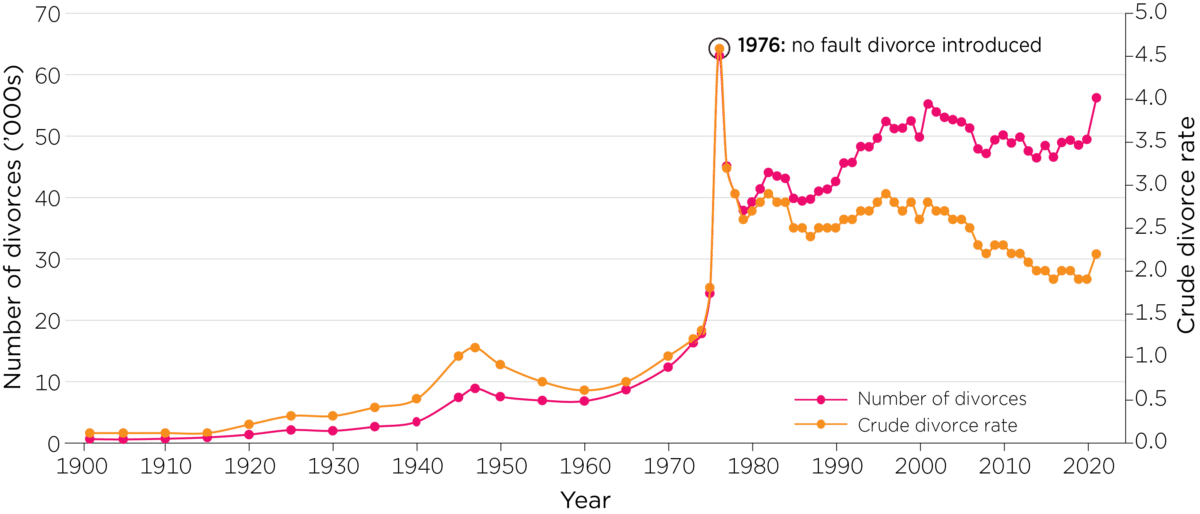A complete legal guide to Australian divorce rates and statistics
Marriage is more than a just ceremony, and divorce is more than a statistic. In 2021 there were 56,244 divorces granted in Australia, 13.6% more than in 2020, and behind each of those divorces lies the memory of a promise to support and love each until death.
By Michael Sheahan.
The tracking of Australian divorce rate data provides important insights into the changing societal beliefs and legislation that shape our relationships.

A divorce rate, or the crude divorce rate, is the number of divorces that happen in Australia each year per 1000 residents. The divorce rate, released by the Australian Bureau of Statistics, is an imperative tool for assessing ongoing changes to relationships in our nation. The most recent data from the 2021 Census puts the crude divorce rate at 2.2 (per 1000 people) and the crude marriage rate at 3.5. The crude divorce rate in Australia has been trending downwards since the 1990s.
Trends in Australian divorce rates
The marriage rate and its relation to the divorce rate
In 2020, we saw hospitals overrun, Netflix subscriptions soar, and the largest drop in marriages ever recorded by the Australian Bureau of Statistics. Discounting this Corona pandemic-induced outlier, the number of marriages has stayed largely stable over the last two decades.
However, in the context of a rapidly growing Australian population, this represents a significant decline in the prevalence of marriage. Since 1970, the Australian population has doubled, and marriages per capita have halved.
So what is happening?
The fall of traditional marriage has coincided with the rise of a less formal arrangement: the de facto relationship. In 2009, reforms to the Family Law Act afforded de facto partners many benefits formerly reserved for married couples. Since 2011, the number of Australians in de facto relationships has increased by 46.8%. This trend recontextualises the falling marriage rate.
When we look at the sum of marriages and de facto relationships as a percentage of the over-15 Australian population, we see that the percentage of Australians that are in either category has remained largely stable over the last decade.
Australians have not abandoned romance. They are merely distancing themselves from the institution of marriage. The Australian statistics on divorce do not include the breakdown of de facto relationships, and so a declining marriage rate contributes to the declining divorce rate.
| Category | 2011 | 2016 | 2021 |
| Australia’s over 15 population | 15,536,806 | 16,777,845 | 18,779,406 |
| In registered marriages | 7,647,042 (49.2%) | 8,001,141 | 8,747,135 |
| In de facto relationships | 1,476,368 | 1,751,731 | 2,168,351 |
| In marriages and de factos | 9,123,410 | 9,752,852 | 10,915,486 |
Source: Australian Family Relationships Report.
Over time societal views on marriage, divorce, and relationships have radically changed. The stigma previously attached to premarital cohabitation and unwedded co-parenting is no longer prevalent in modern Australia. In fact, over a third of children born in 2020 were born outside of wedlock, a term that holds little relevance for most Australians today.
Marriage and divorce have evolved with changes in society, especially shifts in religious observance. In 1971 over 85% of Australians identified as Christian and religious ministers performed 88% of our marriages. In the 2021 census, for the first time in census history, less than half of the country identified as Christian.
Today, civil celebrants perform most marriages. In addition, surveys show that Australians are more accepting of couples living together without any intention to marry and see divorce as a preferable alternative to an unhappy marriage (source). The de-stigmatisation of divorce has freed many Australians to form and end relationships on their own terms and is reflected in our downward trending marriage and divorce rates.
The 1975 Family Law Act (Cth)
Like society, the legal landscape has changed over time to allow people to divorce in a broader set of circumstances. Before introducing the Family Law Act in 1975, divorce was fault-based, and marriage could only be dissolved by establishing cruelty, insanity, or any of the other restrictive grounds set out in the Matrimonial Causes Act 1959.
The introduction of no-fault divorce meant that the only grounds needed were the irretrievable breakdown of marriage, as evidenced by 12 months of separation. Following the Family Law Act’s introduction in 1976, the crude divorce rate reached an all-time peak of 4.6 divorces per 1000 residents. This is presumably due to the backlog of divorces that still need to be, or were waiting to be, approved by the court. Divorce rates lowered significantly in the years following the peak but did not drop as low as before the introduction of no-fault divorce.

Source: Australian Institute of Family Studies.
Australian divorce statistics from the 2021 Census
The Morrison Government’s 2021 legislation merged the Family Court of Australia with the Federal Circuit Court of Australia, forming the Federal Circuit and Family Court of Australia (FCFCOA) effective from September 1, 2021.
The merger aimed to reduce the time required for family court decisions and create a single entry point for family court matters. As a result of this merger, the FCFCOA processed more divorces in 2021 than in previous years, resulting in the highest number of divorces finalised since 1976.
The Australian Bureau of Statistics has advised that because it was administrative changes that enabled the courts to finalise more divorces, the data gathered from that year should be used with caution.
The information gathered by Census provides more statistics than just marriage and divorce rates for analysing relationships in Australia:
- Australians are divorcing older than they have in the past, but this can largely be attributed to the trend of marrying later and an increase in divorces for longer marriages.
- While 41% of divorces were for marriages that lasted for nine years or less, more than a quarter of couples who divorced in 2021 had been married for upwards of 20 years.
- In 2021, the median age for male divorcees in Australia was 45.9 years and 43 years for females.
- The median duration for a marriage that ends in divorce in 2021 was between 12 and 12.2 years.
Gay divorce rates in Australia

The legalisation of same-sex marriage in 2017 has naturally produced the first same-sex divorces in 2021. There has been a total of 473 divorces finalised for same-sex couples in Australia between 2018 and 2021.
As only six years have passed since the first same-sex marriages, we will require further time to elapse until we can get an accurate image of divorce rates amongst same-sex couples.
Conclusion
Divorce rates in Australia have been subject to changes in legislation, civil rights movements, pandemics, and the slow match of progress. The statistics reflect Australia’s changing societal beliefs and the legislation that shapes our relationships.
To learn more about divorce rates, marriage, and the trends that shape society and family law, see Australian Family Lawyers’ Australian Relationships: Love, Marriage, and Divorce in a Modern Nation.
The Australian Relationships Report was released in March of 2023 and uses the most recent statistical data and research to give Australians the Family Lawyers’ insight into family law issues.
Download the report here.
If you’d like to understand the divorce process or have any questions about yours, call our friendly team directly or request a call back via the form below.
Do you have a question about family law or relationship law?
Call now 03 9088 3184
If you would prefer an Australian Family Lawyers team member to contact you, complete the form below.



